Best tablets in 2025 for all budgets
From compact slates to powerhouse devices, our buying guide features the best tablets you can buy right now
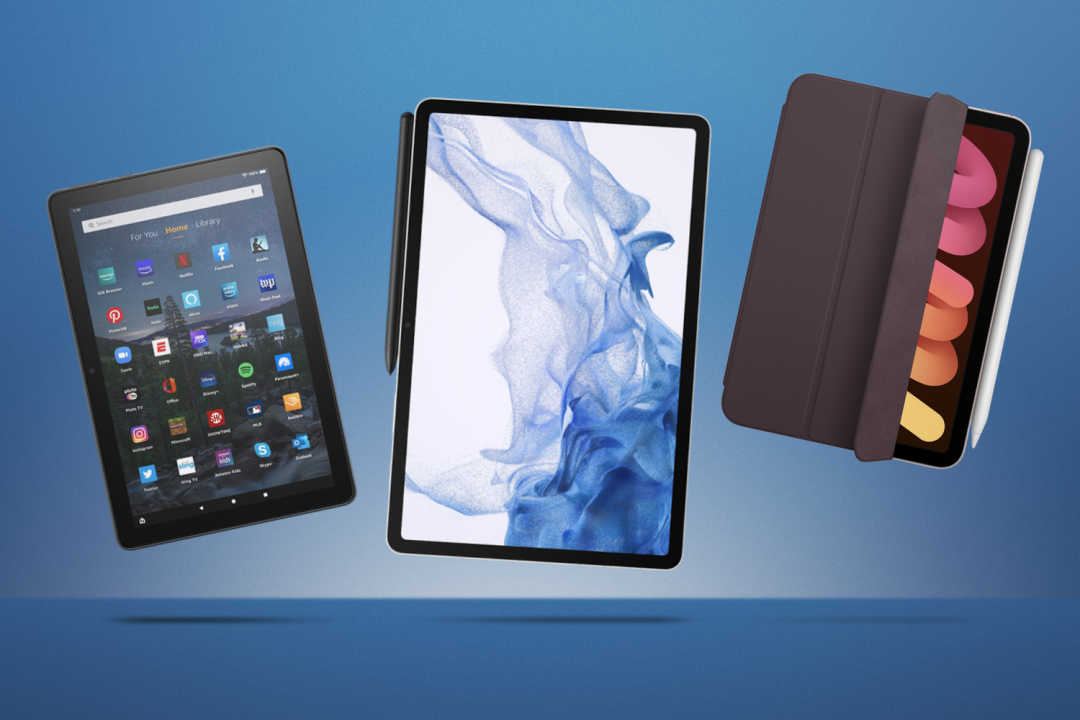
It’s rare that technology circles back to old-school tools, but here we are using styluses to jot down notes on tablets. Of course, today’s versions swap ink and paper for pixels and precision. If you’re shopping for a new tablet for work or leisure, this buying guide has you covered.
Whether you’re tracking expenses, sketching a masterpiece, or relaxing with your favourite reads, modern tablets offer a seamless, superior experience.
From compact models ideal for on-the-go convenience to powerful devices that rival high-performance laptops, we’ve curated the best tablets available right now. Our guide includes top-tier options for ultimate productivity and budget-friendly picks for easy entertainment — because every penny counts.
Why you can trust Stuff: Our team of experts rigorously test each product and provide honest, unbiased reviews to help you make informed decisions. For more details, read how we test and rate products.
Quick list: what’s the best tablet?
We think the Apple iPad Air M2 (buy now) is the best tablet for most people. It’s smart, sleek, and effortlessly smooth to use, thanks to the powerful M2 chip. Its lightweight design makes it a breeze to carry wherever you go.
The Apple iPad Pro M4 (buy now) comes complete with absolutely remarkable enhancements that take the power of the iPad lineup to the next level. It’s so powerful, fast, and ideal for pros.
The Samsung Galaxy Tab S10 Ultra (buy now) is the best Android tablet. It raises the bar for Android tablets yet again – just not by a huge degree from last year’s model. AI additions are welcome, yet creative software still trails the iPad Pro.
The iPad Mini 6th generation (buy now) is a compact yet still premium tablet. It features a strong aluminium case, an excellent screen, and an unrivalled ecosystem of apps.
The Amazon Fire 11 Max (buy now) is an affordable, yet still premium offering from Amazon. It is the largest and most powerful tablet Amazon has ever created.
The Google Pixel Tablet (buy now) is an effective smart display while docked, and a capable entertainment slate while carried around. If you want a pure Google experience, this is it.
The best tablets you can buy today:
Best tablet for most people
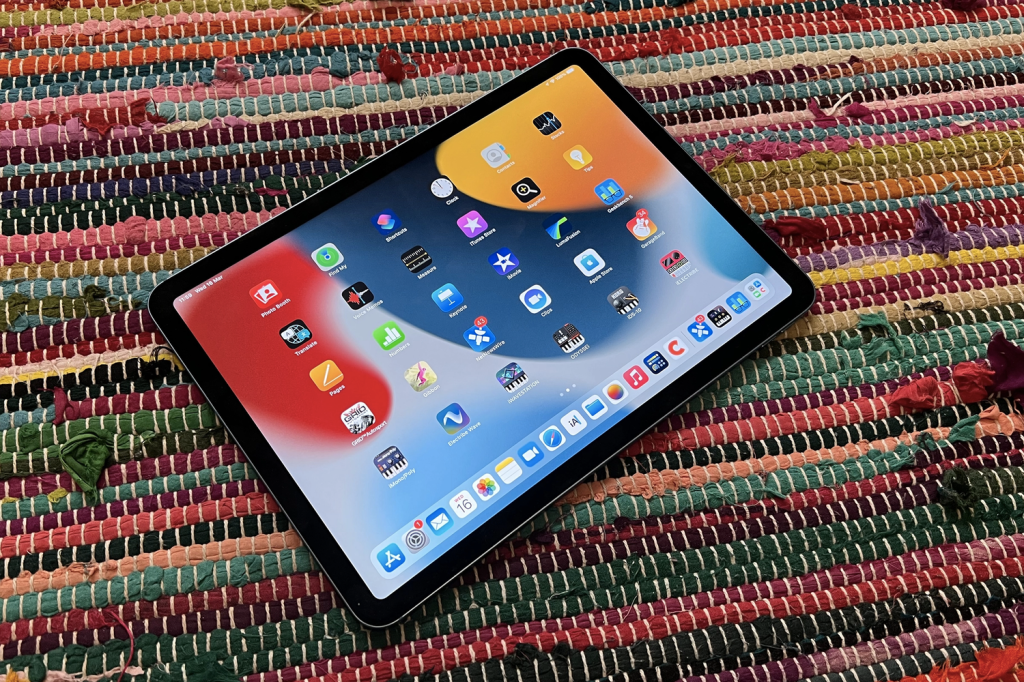
1. Apple iPad Air (M2)
Stuff Verdict
Smart, sleek and slick to use, Apple’s latest tablet is the best for most people thanks to powerful M2 silicon inside and a lightweight design.
Pros
- Powerful M1 chip
- Excellent build quality
Cons
- Only 64GB entry-level storage
- Poor external display support
| Apple iPad Air (M2) specs | |
|---|---|
| Display | 11in 2360×1640 resolution at 264 ppi LED IPS |
| Processor | Apple M2 |
| RAM | 8GB |
| Storage | 128/256/512GB and 1TB |
| Cameras | 12MP (rear), 12MP (front) |
| Battery | 10 hours |
| Connectivity | 5G, Wi-Fi 6, Bluetooth 5.0, Lightning |
| Software | iPadOS |
| Dimensions | 247.6×178.5×6.1mm / 9.75 x 7.03 x 0.24 in |
| Weight | 462g / 16.3 oz |
The iPad Air (M2) strikes the perfect balance between power and portability, making it Apple’s most versatile tablet for everyday users. With the same M2 chip found in the MacBook Air, it delivers lightning-fast performance for creative tasks, multitasking, and even demanding apps like 4K video editing. Whether you’re sketching with the Apple Pencil (2nd gen) or working with the Magic Keyboard, the iPad Air transforms effortlessly from a creative canvas to a productivity powerhouse.
Its 10.9in Liquid Retina display offers stunning clarity, vibrant colours, and True Tone technology for comfortable viewing in any lighting. At just 1lb and 6.1mm thick, it’s remarkably portable, perfect for on-the-go creativity or entertainment. Despite its sleek design, the iPad Air boasts up to 10 hours of battery life and robust 5G connectivity for staying connected anywhere.
With iPadOS unlocking powerful multitasking features, including Stage Manager, the iPad Air is more capable than ever as a laptop alternative. It also supports Apple’s creative apps like Procreate, Final Cut, and Logic Pro, making it ideal for artists, content creators, and professionals alike. If you want power and polish without the Pro price tag, the iPad Air (M2) delivers on all fronts.
Best tablet for pro users
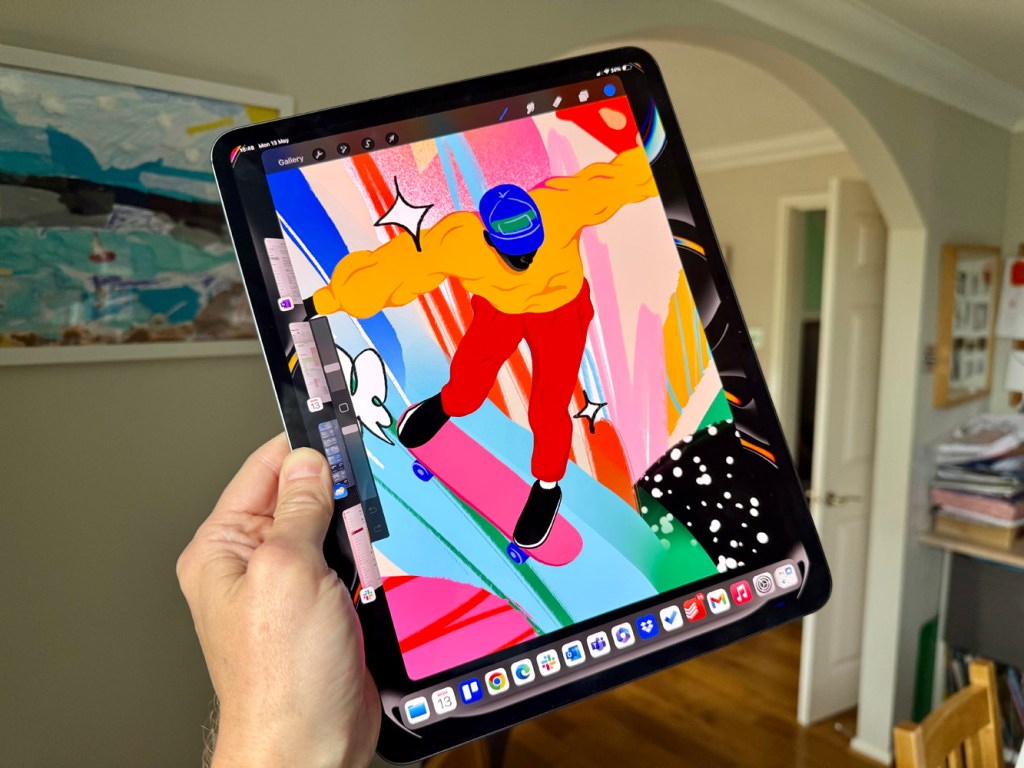
2. Apple iPad Pro (M4)
Stuff Verdict
Absolutely remarkable enhancements that take the power of the iPad lineup to the next level – will there be a root-and-branch review of iPadOS soon to match?
Pros
- M4 is remarkably powerful
- Pencil Pro is terrific
- OLED display is excellent
Cons
- An expensive purchase
- Magic Keyboard is costly
- Should it be thicker but with longer battery life?
| Apple iPad Pro (M4) specs | |
|---|---|
| Display | 13 or 11-inch 2732 x 2064 120Hz Ultra Retina XDR Tandem OLED |
| Processor | Apple M4 |
| RAM | 8/16GB |
| Storage | 128/256/512GB and 1/2TB |
| Cameras | 12MP (rear), 12MP (front) |
| Battery | 10 hours |
| Connectivity | 5G, Wi-Fi 6E, Bluetooth 5.3, USB-C |
| Software | iPadOS |
| Dimensions | 11in: 250 x 178 x 5.3mm (11.10 x 8.50 x 0.20 in) 13in 282 x 216 x 5.1mm (11.10 x 8.50 x 0.20 in) |
| Weight | 11in: 444g or 446g (15.7 oz or 15.8 oz) 13in: 579g or 582g (20.4 oz or 20.5 oz) |
Apple’s iPad Pro (7th gen, M4) is a jaw-dropping powerhouse that redefines tablet performance. With a cutting-edge M4 chip, it offers unmatched speed and graphical capabilities that even outpace Intel’s Core i9 processors in some areas. The new OLED Ultra Retina XDR display is stunning, delivering vibrant colours and incredible contrast. At just 5.1mm thin, it’s Apple’s sleekest design yet, shedding weight without sacrificing durability. Artists and designers will appreciate the new Apple Pencil Pro, which introduces haptic feedback, a pressure-sensitive barrel, and seamless brush switching.
However, the experience isn’t without limitations. While hardware advancements are top-tier, iPadOS continues to lag, creating workflow inefficiencies compared to macOS. The Magic Keyboard is now sturdier but remains eye-wateringly expensive. And though battery life holds up, some might have preferred a thicker design to accommodate even more longevity.
Starting at US$999 / £999, the iPad Pro M4 caters to professionals seeking extreme power and precision. For casual users, the impressive iPad Air with an M2 chip might be more than enough. If you’re in the 1% of creators pushing tech to its limits, this is the tablet to beat—just don’t hold back on hoping for a significant software upgrade at Apple’s next developer event.
- Read more: Apple iPad Pro review (M4) review
Best Android tablet
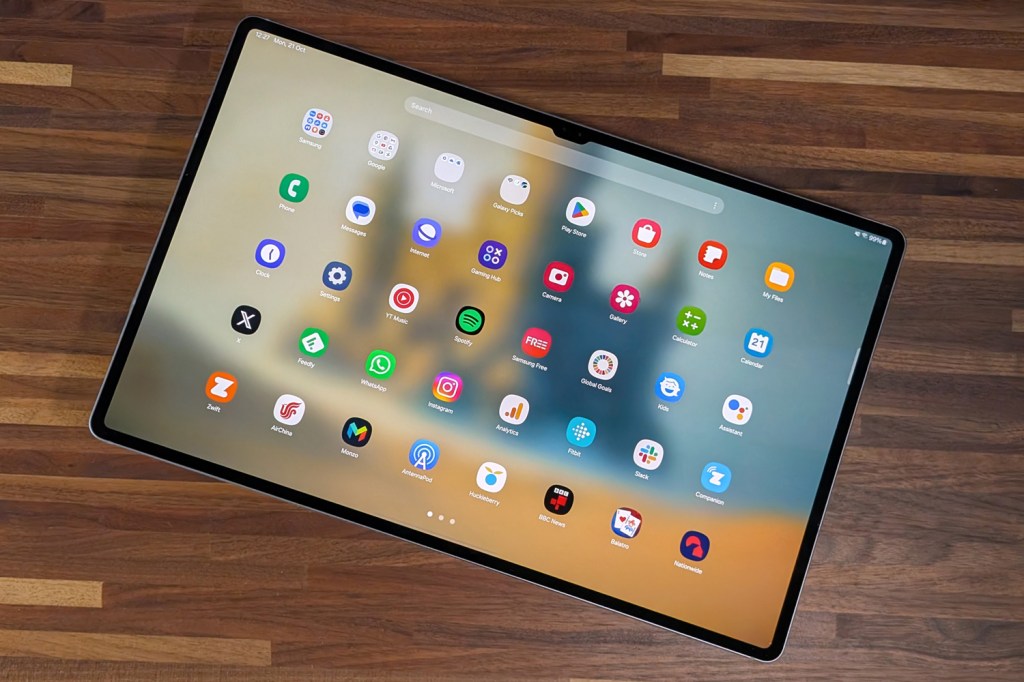
3. Samsung Galaxy Tab S10 Ultra
Stuff Verdict
The Galaxy Tab S10 Ultra raises the bar for Android tablets yet again – just not by a huge degree from last year’s model. AI additions are welcome, yet creative software still trails the iPad Pro.
Pros
- Stunning screen that’s simply massive
- S Pen included and Galaxy AI genuinely useful
- Potent performance for creative jobs and games
Cons
- Beaten on power by an M4 iPad
- iOS has more creator-friendly apps
- Relatively minor upgrade over last year’s effort
| Samsung Galaxy Tab S10 Ultra specs | |
|---|---|
| Screen | 14.6in, 2960×1848, 210Hz AMOLED |
| CPU | MediaTek Dimensity 9300 Plus |
| Memory | 12/16GB |
| Cameras | 13MP + 8MP rear, 12MP+12MP front |
| Storage | 256GB/512GB/1TB, plus microSD expansion |
| Operating system | Android 14 w/ OneUI |
| Battery | 11,200mAh w/ 45W wired charging |
| Dimensions | 209x326x5.4mm |
| Weight | 718g |
The Samsung Galaxy Tab S10 Ultra is a colossal Android powerhouse, setting a new benchmark for high-end tablets. With a mammoth 14.6in anti-reflective AMOLED display, it’s perfect for creative multitasking and immersive media consumption. The vivid screen is bright enough to handle direct sunlight, while the included S Pen enhances productivity and artistic pursuits. AI-powered features, like object removal and real-time transcription, provide meaningful enhancements for note-takers and creatives.
Powered by MediaTek’s Dimensity 9300 Plus chip, the S10 Ultra delivers impressive performance across demanding tasks, rivaling even laptops. Whether sketching, editing 4K videos, or gaming, it handles it all without a hiccup. The battery life is formidable, lasting through intense creative sessions, though you’ll need your own fast charger.
On the downside, Apple’s iPad Pro still leads with better third-party creative software, and the Tab S10 Ultra’s advancements are incremental over its predecessor. But for Android fans seeking the ultimate tablet experience, it’s a stellar choice. With robust build quality, IP68 water resistance, and a seven-year software support promise, the Galaxy Tab S10 Ultra cements itself as the definitive Android tablet – even at its premium price.
- Read more: Samsung Galaxy Tab S10 Ultra review
Best small tablet
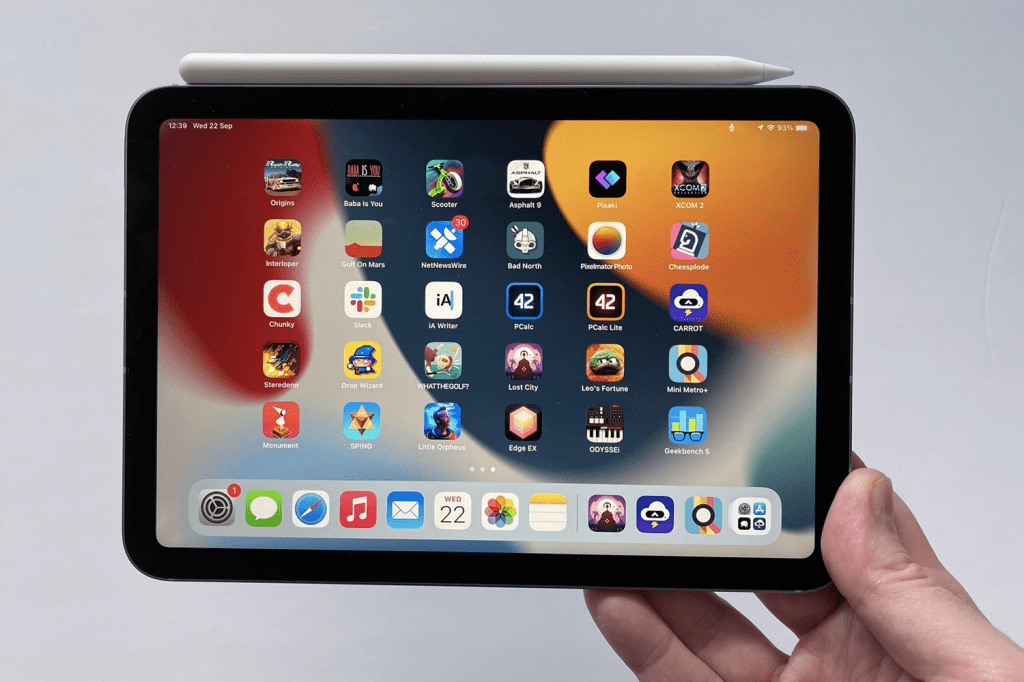
4. Apple iPad Mini (6th generation)
Stuff Verdict
Apple’s refreshed Mini remains a perfectly portable slate. If you have the eyes for its small but sharp display, it’s the compact tablet to beat
Pros
- Perfectly portable
- Packed with high-end tech
Cons
- No Apple hardware keyboard
- Easy-to-muffle speakers
| Apple iPad Mini (6th generation) specs | |
|---|---|
| Display | 8.3in 2266×1488 LED IPS |
| Processor | Apple A15 Bionic |
| RAM | 4GB |
| Storage | 64/256GB |
| Cameras | 12MP (rear), 12MP (front) |
| Battery | 10 hours |
| Connectivity | 5G, Wi-Fi 6, Bluetooth 5.0, USB-C |
| Software | iPadOS 15 |
| Dimensions | 195.4×134.8×6.3mm, 297g |
Styled like an iPad Air that’s shrunk in the wash, the revamped iPad Mini is all screen and all the better for it. A vibrant canvas surrounded by a slim black bezel, it looks great and feels premium. Light at 300g, its smaller-than-A5 dimensions make it a good fit for any satchel.
Despite its dinkier dimensions, you still get a full iPad experience with few compromises. The 8.3in screen doesn’t support 120Hz ProMotion, but it is sharper than any other iPad display at 326ppi. Besides the design, the Mini apes the Air in other ways: True Tone tech, Touch ID in the power button, USB-C connectivity and a 12MP front-facing camera with Centre Stage.
Its 14:9 aspect ratio does mean some apps don’t fill the entire display, but the iPadOS ecosystem otherwise delivers the slick software experience we’ve come to know and love – especially when you use it with Apple’s second-gen Pencil. If you’re shopping for a capable and attractive tablet that’s easier to tote, the 6th-gen iPad Mini should sit top of your list.
- Read more: Apple iPad Mini (6th Generation) review
Best cheap tablet
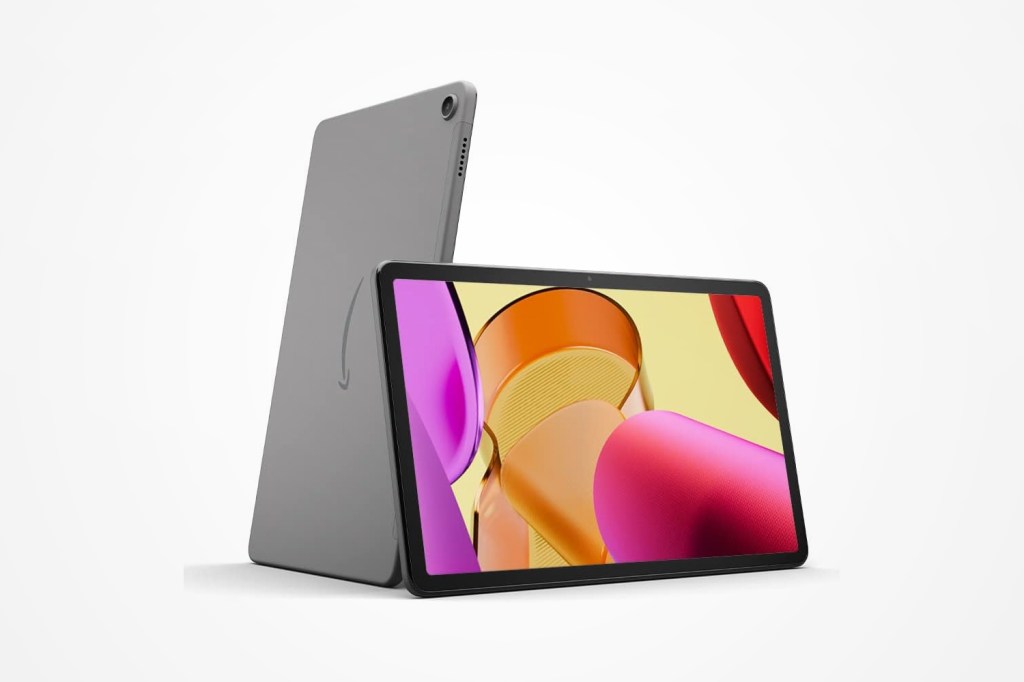
5. Amazon Fire 11 Max
Stuff Verdict
Amazon’s more premium tablet yet, with a large display, great accessories and Alexa smarts
Pros
- Large screen
- Relatively affordable
Cons
- Fire OS isn’t a premium experience
- Scree could be more affordable
| Amazon Fire 11 Max specs | |
|---|---|
| Display | 11in 2000×1200 LED IPS |
| Processor | Mediatek MT8188J (octacore) |
| RAM | 4GB |
| Storage | 64/128GB |
| Cameras | 8MP (rear), 8MP (front) |
| Battery | 14 hours |
| Connectivity | Wi-Fi 6, Bluetooth 5.3, USB-C |
| Software | Fire OS |
| Dimensions | 259.1 x 163.7 x 7.5mm, 490 g |
Dependable without drawing attention, Amazon’s Fire tablets are decent tablets with accessible price tags. The Fire 11 Max is Amazon’s most premium tablet yet, with an 11in 2000 x 1200 display, 2.2GHz octa-core processor and 4GB of RAM. Amazon says it’s 50 percent faster than its next quickest tab.
The 11in display isn’t the sharpest out there, especially when compared to Apple and Samsung, but it’s absolutely fine for browsing and streaming on a daily basis. It’s not just designed for entertainment, though, the Fire Max 11 has an optional full-size keyboard case and a stylus pen that works with Microsoft 365 apps.
Alexa’s on-board, of course, but less impressive is the lack of native Google Play Store support, although it only takes five minutes of tinkering to install it yourself. The OS is predictably Amazon-heavy, but the Fire 11 Max is still a lot of tablet for the cash.
- Read more: Amazon Fire 11 Max
Best Google tablet
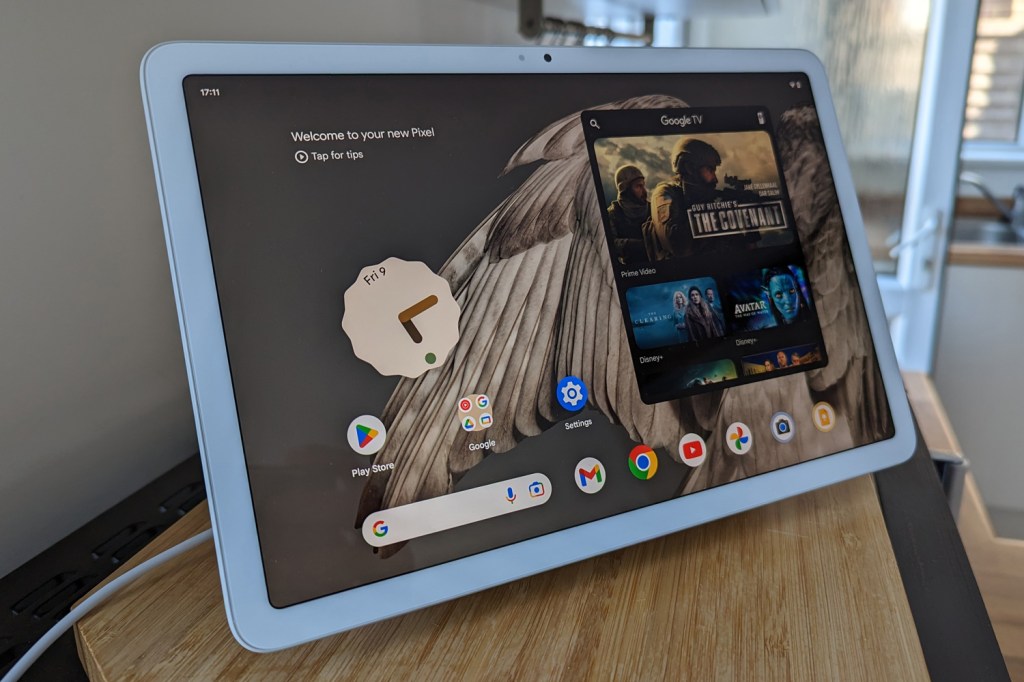
6. Google Pixel Tablet
Stuff Verdict
The 2-in-1 tablet is an effective smart display while docked, and a capable entertainment slate while carried around
Pros
- New tablet UI and optimise apps much better than older efforts
- Bright and colourful screen well suited to streaming video
Cons
- Dock is dumb once you take off the tablet
- App ecosystem still behind Apple
| Google Pixel Tablet specs | |
|---|---|
| Display | 10.95in, 2560×1600 LCD |
| CPU | Google Tensor G2 |
| Memory | 8GB RAM |
| Storage | 128/256GB on-board |
| Cameras | 8MP rear, 8MP front |
| Operating system | Android 13 |
| Battery | 12 hours |
| Dimensions | 258x169x8.1mm, 493g |
Is it an iPad rival? A smart display you don’t have to keep tethered to a single spot? Or Google’s latest vision for what Android should look like on bigger screens? The Pixel Tablet is a bit of all three.
This is Google’s first home-grown tablet in five years and what makes it stand out from the crowd is that it ships with a bundled speaker dock, so it turns into a Nest Home Hub when not in your hands. This makes it very useful, as you’re essentially getting two devices in one.
It also ships with a new version of Android 13 that’s been properly optimised for tablets. It’s still not perfect, but a big step in the right direction.
Google fans hoping the Pixel Tablet was going to wipe the floor with every iPad are going to be disappointed, but those with more realistic expectations are in for a treat.
- Read more: Google Pixel Tablet review
What to look for when buying the best tablet
When buying the best tablet, first you’ll need to consider its purpose and how it will be used. For general usage like browsing, streaming, and light gaming, a mid-range tablet with a decent processor, sufficient RAM (at least 4GB), and a good display resolution (Full HD or higher) will suffice.
Whereas if the tablet is for professional use, such as graphic design, video editing, or multitasking with demanding applications, look for higher-end models with powerful processors (like the Apple M2 or Qualcomm Snapdragon 8 Gen 2 series), more RAM (8GB or more), and higher storage capacity (128GB or more), along with expandable storage options.
The operating system is also a crucial factor, with iOS and Android being the primary options. The Apple iPad with iOS offers a smooth, integrated experience with a vast app ecosystem optimised for tablets, it’s perfect if you already have other Apple devices.
Android tablets, on the other hand, provide more flexibility and customisation, with a wide range of models to suit various budgets.
We’ve touched on it before, but the display quality really is a key feature for tablets. Consider the display size, resolution, brightness, and colour accuracy, especially if the tablet will be used for media consumption or creative work.
While a tablet’s battery life is important, it’s not quite as vital as a smartphone’s battery life. This is because a good tablet should last at least 8-10 hours on a single charge, but tablets are generally used at home or near a charging outlet (not out and about like phones).
If you’re looking for something a little more affordable, check out the best cheap tablets, and, if you’re only interested in Apple tech, then check out our guide to the best iPad.
Finally, you’ll also want to consider additional features such as stylus support, keyboard compatibility, and connectivity options (like USB-C, HDMI, or 5G capability) depending on how you plan to use your tablet.
How we test tablets
We have used and reviewed every tablet on this list, so you can trust us when it comes to recommending the best tablet to buy.
Our extensive hands-on experience with countless devices ensures that we provide reliable and well-informed recommendations. Each tablet has been thoroughly tested to ensure it meets the high standards we set for performance, usability, and overall value.
We usually spend a week or longer reviewing tablets, immersing ourselves in their daily use to thoroughly evaluate all of the software features, build quality, and performance. This extended period allows us to experience the tablet as an average user would, identifying both strengths and weaknesses that may not be immediately apparent. Our testing process is designed to uncover how well the tablet performs under various conditions, ensuring our reviews are not just surface-level observations but deep, meaningful analyses.
Our reviews are very comprehensive, covering every single aspect of a tablet, including battery life, quality of the display, and overall performance. We rigorously test battery longevity under different usage scenarios to provide an accurate picture of real-world endurance. The display is evaluated for brightness, colour accuracy, and resolution to determine its quality. Performance testing includes running various applications and multitasking to assess the tablet’s capability to handle daily tasks efficiently. Basically, we aim to give you a complete understanding of each tablet’s capabilities, helping you make an informed purchasing decision.
Find out more about how we test and rate products.


